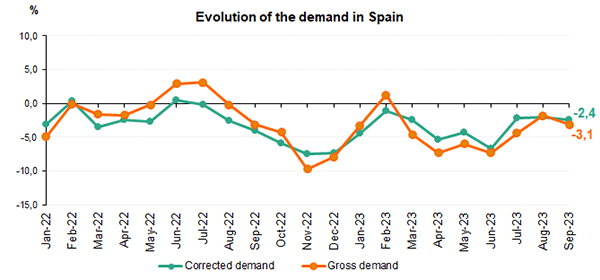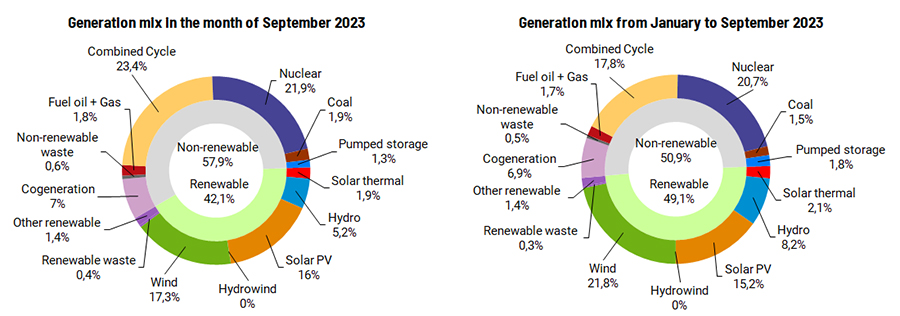Discover what Red Eléctrica is, what we do, and why we are the backbone of the electricity system in Spain and the ecological transition.
Demand for electricity in Spain falls 2.4% in September
- 42.1% of electricity production during the month came from renewable sources and 68.8% was obtained using zero-carbon energy technologies.
- Solar photovoltaic increased its production by 23.3% compared to September 2022.

National electricity demand in September experienced a 2.4% decrease year-on-year after having factored in the influence of seasonal and working patterns. In gross terms, demand is estimated at 19,670 GWh, down 3.1% on September 2022.

In the year to date, Spain has registered a cumulative demand of 183,762 GWh, down 4.1% on the same period in 2022. Once again, after having factored in the influence of seasonal and working patterns, demand fell by 3.4% year-on-year.
In September, renewables generated 42.1% of the total electricity produced nationwide, registering 8,778 GWh, according to data available at the time of this press release. Wind power contributed to this figure, with a production of 3,600 GWh, representing 17.3% of the total generation mix.
Solar photovoltaic energy accounted for 23.3% more GWh this September than in the same month of 2022 and was responsible for 16% of the energy produced during the month. In fact, during September (on the 5th to be precise), the cumulative solar photovoltaic generation for 2023 so far exceeded that for the whole of 2022, which stood at 27,902 GWh.
Furthermore, 68.8% of the month's electricity production was obtained using zero-carbon energy technologies.
In the first nine months of 2023, renewable production grew by 12.2% compared to the same period last year.

Demand for electricity in the peninsular system
Regarding the mainland electricity system, and after having factored in the influence of seasonal and working patterns, demand for electrical energy in September was 2.6% lower than the same month in 2022. In gross terms, demand stood at 18,309 GWh, down 3.4% year-on-year.
In the first nine months of the year, electricity demand on the Spanish mainland stood at 172,267 GWh, a 4.3% decrease compared to 2022. Again, after having factored in the influence of seasonal and working patterns, demand fell by 3.6%.
Renewables as a whole generated 43.8% of the peninsular total and 68% of the electricity was obtained using zero-carbon energy technologies.
Electricity demand in the Balearic Islands and the Canary Islands
Electricity demand in the Balearic Islands in September, after having factored in the influence of seasonal and working patterns, was 5.6% lower than in the same month in 2022. Thus, gross monthly demand is estimated at 569,897 MWh, down 4.2% on that registered in September 2022. In the first nine months of 2023, gross demand in the Balearic Islands is estimated at 4,708,746 MWh, down 2.2% year-on-year.
In terms of generation, combined cycle, with 70.2% of the energy produced in the Balearic Islands, was the leading energy source in the islands in September. For its part, renewable energy obtained using zero-carbon energy technologies in the Balearic Islands represented 10.3% of the total. In addition, this month, the subsea link between the mainland and Majorca contributed to covering 22.9% of the electricity demand in the Balearic Islands.
For its part, and after having factored in the influence of seasonal and working patterns, electricity demand in the Canary Islands increased by 4.8% year-on-year. In gross terms, demand was 757,004 MWh, up 4.5%. So far this year, demand in the Canary Islands is estimated at 6,490,839 MWh, up 1.8% compared to the same period in 2022.
In terms of electricity generation in the Canary Islands, combined cycle, with 45.4% of the total, was also the leading technology in September, while renewables and generation obtained using zero-carbon energy technologies produced 18.3% of the production this month, with wind generating 13.9% of the total.
Consult our Daily Balance Report for more information on the National, Peninsular, Balearic Islands and Canary Islands electricity systems as at the close of September.
Downloads











